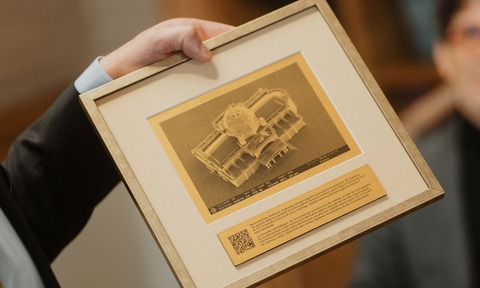Hair’s breadth ‘chapel on a chip’ demonstrates wonders of laser manufacturing
6 Jul 2025

Sorbonne university’s Chapel of Saint Ursula has been a Parisian landmark for nearly four centuries, famous as the resting place of the 17th century statesman Cardinal Richelieu.
Thanks to manufacturing science, the monumental icon now has a microscopic double barely larger than the width of a human hair.
Presented to university president, professor Nathalie Drach-Temam, during a recent visit to Lithuania’s Vilnius University, the model was designed by senior researcher at the faculty of physics, Dr Gordon Zyla, with advanced laser nanofabrication multiphoton 3D lithography techniques.
‘The length of the chapel is approximately 120 micrometres, making it slightly larger than the width of a human hair,” said Zyla.
“What is most impressive, however, is first that the miniature is about 275,000 times smaller than the original and second, that despite this extreme downscaling, the intricate architectural details of the original are still preserved in the printed version,” he outlined.
“Unlike conventional 3D printing, this approach can solidify a light-sensitive material at virtually any point in space, enabling the fabrication of truly three-dimensional structures. Interestingly, by using a sharply focused ultrashort-pulse laser beam, it is possible to initiate a polymerisation reaction with such precision that it creates spatial elements (voxels) just a few hundred nanometres in size.”
He added, for comparison, that a human hair is about 80 micrometres thick – some 500 times wider than the structures that can be created by the method.
Zyla’s chapel provides an illustration of the research in light technologies being carried out at the university’s Laser Research Centre, within the laser nanophotonics group led by Prof. Mangirdas Malinauskas.
As an example of the work, Zyla cited spherical microelements six times smaller than the chapel that could improve optical microscope resolution beyond the capabilities of standard lenses.
“Other tiny structures, carefully arranged in patterns, can shape and control light in new ways to enable novel interactions with matter. This may open up possibilities for future applications in bio-imaging, quantum technologies, telecommunications, and laser technologies,” he added.

